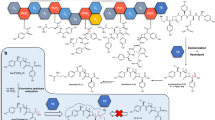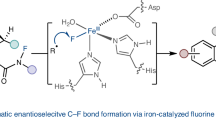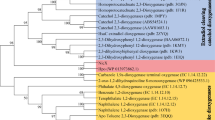Abstract
(S)-2-hydroxypropylphosphonate ((S)-2-HPP) epoxidase (HppE) is a mononuclear non-haem-iron-dependent enzyme1,2,3 responsible for the final step in the biosynthesis of the clinically useful antibiotic fosfomycin4. Enzymes of this class typically catalyse oxygenation reactions that proceed via the formation of substrate radical intermediates. By contrast, HppE catalyses an unusual dehydrogenation reaction while converting the secondary alcohol of (S)-2-HPP to the epoxide ring of fosfomycin1,5. Here we show that HppE also catalyses a biologically unprecedented 1,2-phosphono migration with the alternative substrate (R)-1-HPP. This transformation probably involves an intermediary carbocation, based on observations with additional substrate analogues, such as (1R)-1-hydroxyl-2-aminopropylphosphonate, and model reactions for both radical- and carbocation-mediated migration. The ability of HppE to catalyse distinct reactions depending on the regio- and stereochemical properties of the substrate is given a structural basis using X-ray crystallography. These results provide compelling evidence for the formation of a substrate-derived cation intermediate in the catalytic cycle of a mononuclear non-haem-iron-dependent enzyme. The underlying chemistry of this unusual phosphono migration may represent a new paradigm for the in vivo construction of phosphonate-containing natural products that can be exploited for the preparation of new phosphonate derivatives.
This is a preview of subscription content, access via your institution
Access options
Subscribe to this journal
Receive 51 print issues and online access
$199.00 per year
only $3.90 per issue
Buy this article
- Purchase on Springer Link
- Instant access to full article PDF
Prices may be subject to local taxes which are calculated during checkout





Similar content being viewed by others
References
Liu, P. et al. Protein purification and function assignment of the epoxidase catalyzing the formation of fosfomycin. J. Am. Chem. Soc. 123, 4619–4620 (2001)
Liu, P. et al. Biochemical and spectroscopic studies on (S)-2-hydroxypropylphosphonic acid epoxidase: a novel mononuclear non-heme iron enzyme. Biochemistry 42, 11577–11586 (2003)
Higgins, L. J., Yan, F., Liu, P., Liu, H.-w. & Drennan, C. L. Structural insight into antibiotic fosfomycin biosynthesis by a mononuclear iron enzyme. Nature 437, 838–844 (2005)
Stengel, D. et al. Second-line treatment of limb-threatening diabetic foot infections with intravenous fosfomycin. J. Chemother. 17, 527–535 (2005)
Hammerschmidt, F., Bovermann, G. & Bayer, K. Biosynthesis of natural products with a P-C Bond. 5. The oxirane oxygen atom of fosfomycin is not derived from atmospheric oxygen. Justus Liebigs Ann. Chem. 1055–1061 (1990)
Marquardt, J. L. et al. Kinetics, stoichiometry, and identification of the reactive thiolate in the inactivation of UDP-GlcNAc enolpyruvoyl transferase by the antibiotic fosfomycin. Biochemistry 33, 10646–10651 (1994)
Brown, E. D., Vivas, E. I., Walsh, C. T. & Kolter, R. MurA (MurZ), the enzyme that catalyzes the first committed step in peptidoglycan biosynthesis, is essential in Escherichia coli. J. Bacteriol. 177, 4194–4197 (1995)
Ko, K. S. et al. In vitro activity of fosfomycin against ciprofloxacin-resistant or extended-spectrum β-lactamase-producing Escherichia coli isolated from urine and blood. Diagn. Microbiol. Infect. Dis. 58, 111–115 (2007)
Nakazawa, H., Kikuchi, Y., Honda, T., Isago, T. & Nozaki, M. Enhancement of antimicrobial effects of various antibiotics against methicillin-resistant Staphylococcus aureus (MRSA) by combination with fosfomycin. J. Infect. Chemother. 9, 304–309 (2003)
Cassone, M., Campanile, F., Pantosti, A., Venditti, M. & Stefani, S. Identification of a variant “Rome clone” of methicillin-resistant Staphylococcus aureus with decreased susceptibility to vancomycin, responsible for an outbreak in an intensive care unit. Microb. Drug Resist. 10, 43–49 (2004)
Seidel, H. M., Freeman, S., Seto, H. & Knowles, J. R. Phosphonate biosynthesis: isolation of the enzyme responsible for the formation of a carbon–phosphorus bond. Nature 335, 457–458 (1988)
Liu, S., Lu, Z., Jia, Y., Dunaway-Mariano, D. & Herzberg, O. Dissociative phosphoryl transfer in PEP mutase catalysis: structure of the enzyme/sulfopyruvate complex and kinetic properties of mutants. Biochemistry 41, 10270–10276 (2002)
Hidaka, T. et al. Cloning and nucleotide sequence of fosfomycin biosynthetic genes of Streptomyces wedmorensis. Mol. Gen. Genet. 249, 274–280 (1995)
Woodyer, R. D., Li, G. Y., Zhao, H. M. & van der Donk, W. A. New insight into the mechanism of methyl transfer during the biosynthesis of fosfomycin. Chem. Commun. 359–361 (2007)
Yan, F., Li, T., Lipscomb, J. D., Liu, A. & Liu, H.-w. Site-directed mutagenesis and spectroscopic studies of the iron-binding site of (S)-2-hydroxypropylphosphonic acid epoxidase. Arch. Biochem. Biophys. 442, 82–91 (2005)
Kovaleva, E. G. & Lipscomb, J. D. Versatility of biological non-heme Fe(II) centers in oxygen activation reactions. Nature Chem. Biol. 4, 186–193 (2008)
Zhao, Z. et al. Mechanistic studies of HPP epoxidase: configuration of the substrate governs its enzymatic fate. Angew. Chem. Int. Edn Engl. 41, 4529–4532 (2002)
Yun, D. et al. Structural basis of regiospecificity of a mononuclear iron enzyme in antibiotic fosfomycin biosynthesis. J. Am. Chem. Soc. 133, 11262–11269 (2011)
Yan, F. et al. Determination of the substrate binding mode to the active site iron of (S)-2-hydroxypropylphosphonic acid epoxidase using 17O-enriched substrates and substrate analogues. Biochemistry 46, 12628–12638 (2007)
Costas, M., Mehn, M. P., Jensen, M. P. & Que, L., Jr Dioxygen activation at mononuclear nonheme iron active sites: enzymes, models, and intermediates. Chem. Rev. 104, 939–986 (2004)
Huang, H. et al. Evidence for radical-mediated catalysis by HppE: a study using cyclopropyl and methylenecyclopropyl substrate analogues. J. Am. Chem. Soc. 134, 13946–13949 (2012)
Yamashita, M., Sugiura, M., Oshikawa, T. & Inokawa, S. Synthesis of dimethyl (1-nitromethylalkyl)phosphonates and their conversion to dimethyl (1-formylalkyl)phosphonates by oxidation with ozone. Synthesis 1987, 62–64 (1987)
Churi, R. H. & Griffin, C. E. 1,2 shifts of dialkoxyphosphono groups in skeletal rearrangements of α,β-epoxyvinylphosphonates. J. Am. Chem. Soc. 88, 1824–1825 (1966)
Girotra, N. N. & Wendler, N. L. Synthesis and transformations in the phosphonomycin series. Tetrahedr. Lett. 10, 4647–4650 (1969)
Lesburg, C. A., Caruthers, J. M., Paschall, C. M. & Christianson, D. W. Managing and manipulating carbocations in biology: terpenoid cyclase structure and mechanism. Curr. Opin. Struct. Biol. 8, 695–703 (1998)
Kappock, T. J. & Caradonna, J. P. Pterin-dependent amino acid hydroxylases. Chem. Rev. 96, 2659–2756 (1996)
Mirica, L. M., McCusker, K. P., Munos, J. W., Liu, H.-w. & Klinman, J. P. 18O kinetic isotope effects in non-heme iron enzymes: probing the nature of Fe/O2 intermediates. J. Am. Chem. Soc. 130, 8122–8123 (2008)
Yan, F., Munos, J. W., Liu, P. & Liu, H.-w. Biosynthesis of fosfomycin, re-examination and re-confirmation of a unique Fe(II)- and NAD(P)H-dependent epoxidation reaction. Biochemistry 45, 11473–11481 (2006)
van der Donk, W. A., Krebs, C. & Bollinger, J. M. Substrate activation by iron superoxo intermediates. Curr. Opin. Struct. Biol. 20, 673–683 (2010)
Acknowledgements
We thank W. Johnson and S. Sorey for assistance with the NMR experiment setup. This work is supported in part by grants from The National Institutes of Health (GM040541 to H.-w.L.) and the Welch Foundation (F-1511). C.L.D. is a Howard Hughes Medical Institute Investigator. Crystallographic data collection were conducted at the Advanced Light Source, a Department of Energy (DOE) national user facility (Contract DE-AC02-05CH11231), at beamline 8.2.2 operated by the Berkeley Center for Structural Biology, which is supported in part by DOE and National Institutes of Health/National Institute of General Medical Sciences.
Author information
Authors and Affiliations
Contributions
H.-w.L. provided the scientific direction and overall experimental design for the studies. W.-c.C. performed many of the experiments described herein. M.D. and C.L.D. collected and interpreted all of the crystallographic data. P.L., S.-J.M. and Z.K.Z. designed and carried out the initial biochemical as well as model system studies. S.O.M. performed the DFT calculations. W.-c.C., M.D., P.L., S.O.M., C.L.D. and H.-w.L. wrote the manuscript.
Corresponding author
Ethics declarations
Competing interests
The authors declare no competing financial interests.
Supplementary information
Supplementary Information
This file contains Supplementary Text and Data (see contents for details), Supplementary Figures 1-8, Supplementary Tables 1-2 and Supplementary References. (PDF 2019 kb)
Rights and permissions
About this article
Cite this article
Chang, Wc., Dey, M., Liu, P. et al. Mechanistic studies of an unprecedented enzyme-catalysed 1,2-phosphono-migration reaction. Nature 496, 114–118 (2013). https://doi.org/10.1038/nature11998
Received:
Accepted:
Published:
Issue Date:
DOI: https://doi.org/10.1038/nature11998
This article is cited by
-
Dioxygen activation by nonheme iron enzymes with the 2-His-1-carboxylate facial triad that generate high-valent oxoiron oxidants
JBIC Journal of Biological Inorganic Chemistry (2017)
-
A pyridoxal phosphate–dependent enzyme that oxidizes an unactivated carbon-carbon bond
Nature Chemical Biology (2016)
-
Positive and radical
Nature (2013)
Comments
By submitting a comment you agree to abide by our Terms and Community Guidelines. If you find something abusive or that does not comply with our terms or guidelines please flag it as inappropriate.



